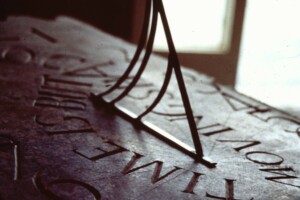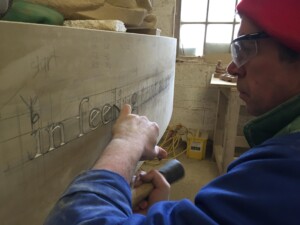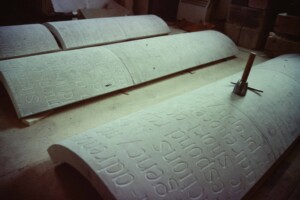Half a lifetime carving letters in stone.
In December 1995 I set up a small workshop in a craft centre in Leicestershire having left art college earlier that year. My intention was to sell small sculptures from this workshop to the general public. Very quickly it became apparent that this was going be extremely difficult. First of all, the public had no interest whatsoever in buying any of the abstract works of art, the type that I had been happily creating in my time at Loughborough art college for the previous 3 years. They wanted functional pieces that they could display in their gardens, birdbaths and seats, sometimes figurative work would sell.
One of the best pieces of advice I was given at art college was “Don’t turn anything down”, advice that has stood me in good stead over the years, learning new skills and stepping outside of my comfort zone. So, when someone came into my workshop and asked for a house plaque, obviously I said – “No problem”. After a couple of practice letters and some advice from a nearby sign writer, I drew the letters on the stone and carved out the plaque. Honestly, it was awful. The letters were badly drawn, the lines were wobbly and chipped and the depth of the letters was inconsistent. If this was your plaque, I’m truly sorry. For the last 29 years, I have been practicing and practicing, trying find that perfect letter. Things have definitely improved!

Hand carved lettering for a sundial in 1997
By 1999, I was becoming a competent letter cutter. I had been carving sundials, birdbaths and seats with inscriptions that would sell at prestigious venues such as Hampton Court Palace show (the craft centre was too quiet) before I designed a large sculpture that was to be located in Astra Zenica Pharmaceuticals new building in Loughborough. The stone I chose was Hoptonwood limestone, a Derbyshire stone that I have subsequently realised, having tried carving most stones in the UK, to be by far the best stone for letter carving and carving sculpture. No doubt, Henry Moore, Barbara Hepworth and Eric Gill had worked that out for themselves too. In 1995, it was available in large blocks and I regularly used it for sculpture. Sadly this is no longer the case and you would struggle to obtain a piece suitable for a headstone.
My sculpture for Astra Zenica was a success, a cylindrical artwork with the carved inscription, relating to cures for asthema spiralling around it. There were approximately 3000 letters to carve on that one. They say that you need to spend 10,000 hours practicing a skill in order to be proficient, I reckon I rattled a few up on that project.

Hoptonwood limestone sculpture for Astra Zenica.
The Sir Bobby Robson Memorial
Years of designing inscriptions, carving them into and around sculptures and into different textures of stones was to prove invaluable when designing a memorial sculpture for former England Football manager, Sir Bobby Robson in 2011. I had worked with Elsie, his widow to develop the designs for the piece which would be a timeline of the career of Sir Bobby.
I quickly became aware that he had been a very busy man. There was a lot of information to incorporate into the artwork which was to be carved in relief, across 5 blocks of Portland stone. The artwork was destined for a small park close to Newcastle United’s football ground. The 2nd in the row of 5 stones was designed with the trophies that Sir Bobby had won (FA Cup, UEFA cup and Cup Winners Cup) carved in relief but with rounded soft edges. Across the face of the entire stone, I carved the names of every club that Bobby had represented, both as a player and a manager. The wonderful thing about this piece was how the sculpture changed in different lights. Sometimes the lettering would leap out of the stone, in other lights, the lettering would be less prominent and the relief sculpture would come to the fore.

I rarely paint my letters, only really when the client insists upon it or the stone demands it. Letters carved into a speckled granite for instance, completely disappear. Letters that are not hand cut and do not have the V-cut, so wonderful at creating a shadow even in poor light, will almost certainly require painting.
The Bevin Boys Memorial
Not long after the Sir Bobby memorial, I was asked to create a sculpture to commemorate the Bevin Boys at the National Memorial Arboretum. This was to be the first of several large scale memorial sculptures that I have had the honour to create at this distinguished venue. I was initially approached by a gentleman by the name of Harry Parkes who was a former Bevin Boy, now in his nineties. We decided that for this mining related memorial that we didn’t want a shiny, polished granite memorial. We wanted a sculpture that better reflected the horrible dirty graft of the coal miners. We decided to use Kilkenny Limestone, a tough, grey Irish stone that would turn black (coal-like) when wet. It was also a good carving stone, ideal for what we had in mind. We flew to the quarry in southern Ireland where Harry was able to hand pick some of the craggiest, most horrible looking pieces of Kilkenny Limestone that we could find.
The design of the memorial meant that some of the carving was into some of the nasty faces while the main inscription was to be carved into one of the flatter surfaces which had a flamed finish. The carving process was challenging, each letter individually designed to compensate for the undulations of the rock. It was often a battle to carve so that it read effectively. The finished piece was unique and a far better reflection of the work of the miners than a machine cut inscription.

The Bevin Boys memorial
Carving inscriptions into rough faces can be difficult but the results are usually worthwhile. A great contrast can be achieved between the crisp edges of the hand cut letter and the natural, undulating, misbehaving surface of the rock. This would be impossible to achieve by a machine which would require a template to stick the surface of the stone.
I have subsequently hand carved inscriptions into many public artworks over the years but occasionally had to turn to the devil and have inscriptions sandblasted or cut by machines. The reasons for this being either time constraints or just the sheer volume of letters that would take forever to carve by hand. Sandblasting letters is the cheapest alternative, a template being placed onto the stone and blasted with sand to create a recess in the stone. The stone needs to be flat for this purpose and the recess achieved is flat or slightly rounded. It does not provide the clinical V-cut that hand carving achieves and generally requires painting.
The other method that I have employed is having the letters CNC ‘d (Computer Numerical Control) which can achieve a V-cut extremely well and at a very steep depth if required. Again, this can only be carried out on a flat surface and in factory conditions.
The main downside to machine cut or sandblasted letters is the design of the letters which I find to be over formal. Too good. They literally look like a machine has made them! There is no allowance for creative design or spontaneous flourishes with the letters. Quite frankly they appear regimental and lifeless. Only hand drawn, considered fonts and letters can really sing and bring a project to life. This is something that I always strive to achieve and I hope that I have been successful with that in some of the many projects that I have worked on during my half a lifetime carving letters in stone.

Carving slate destined for Caernarfon Castle.

Carved lettering into stone seating

Carving the inscription for the Scouts Memorial at the National Memorial Arboretum

Carving into a rough boulder for the Defence and National Rehabilitation Centre.



